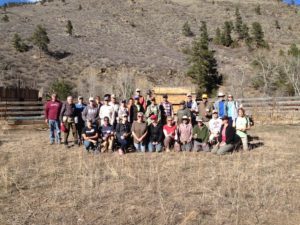Emily’s proposal was to repair a section of the damaged riparian zone (the river bank) of the Big Thompson River by planting grass seeds to promote a healthier river.
In 2013, one of the biggest floods in Colorado history occurred. This flood not only destroyed many homes and businesses, but also changed the course of the river and took out a multitude of trees, grasses, and shrubs in the riparian zone. Without this vegetation, an excess of sediment can run into the river, and a number of unwanted problems can result from this. For example, the depth of the river decreases which increases the temperature of the water. An increase in temperature can decrease the amount of fish and other macroinvertebrates that are able to live there, and therefore decreasing the amount of biodiversity in the river. Replenishing the vegetation will help to prevent future flood damage and maintain the health of the river.  Emily’s solution for these problems was to gather volunteers and plant seeds and a variety of plants along a highly damaged stretch of the river bank.
Emily’s solution for these problems was to gather volunteers and plant seeds and a variety of plants along a highly damaged stretch of the river bank.
Timeline and Budget:
- Feb. 2016- End of March: Multiple correspondents/ conversations with Wildlands Restoration Volunteers in order to join forces in a project they had already begun.
- March 2016: Hung flyers and spread word about the project in order to gather volunteers. Budget of $10.
- April 2nd: Planted native grasses along a 1 mile stretch of the Lower North Fork of the Big Thompson. Total cost was $3,338. Caring for Our Watersheds contributed $800.
